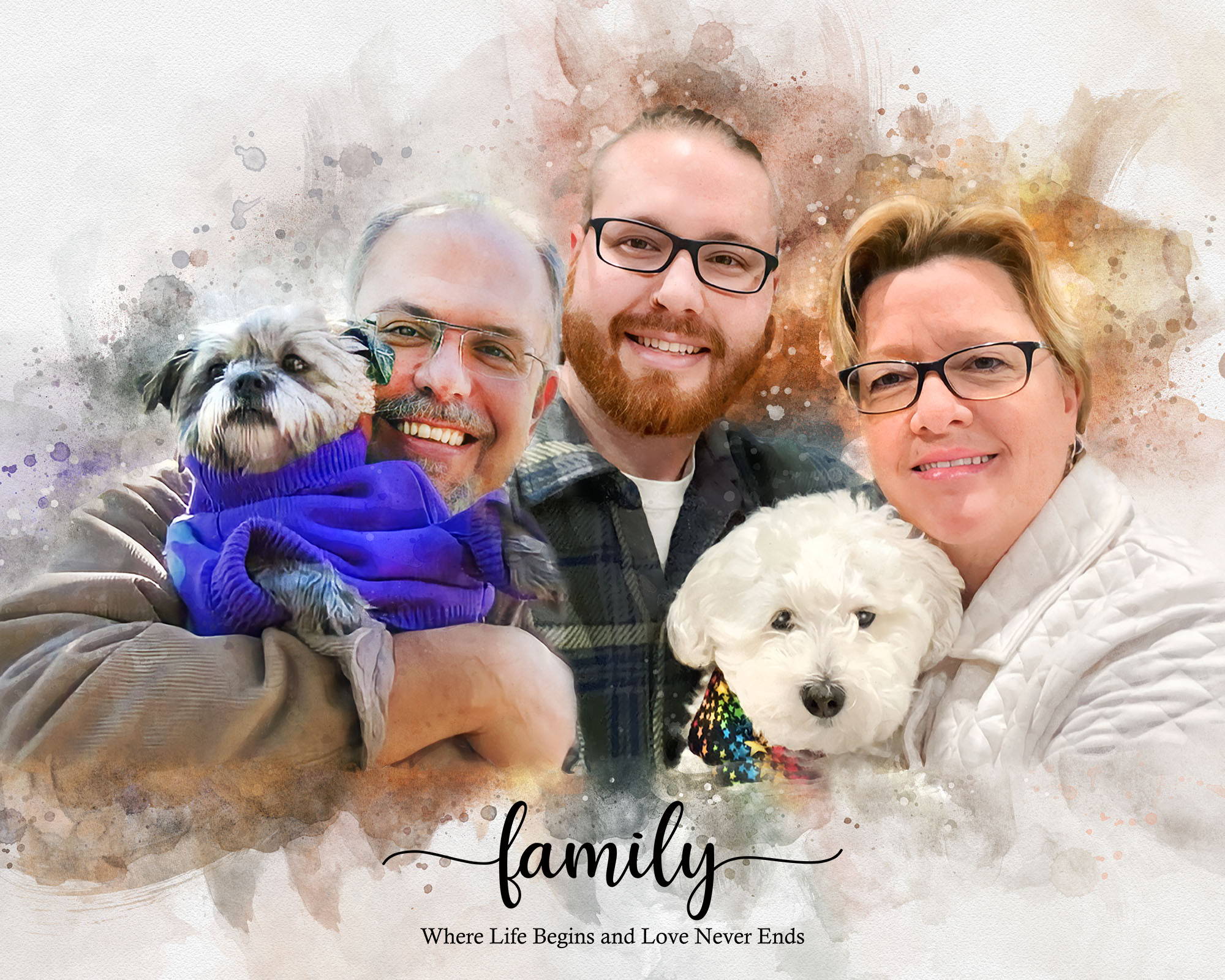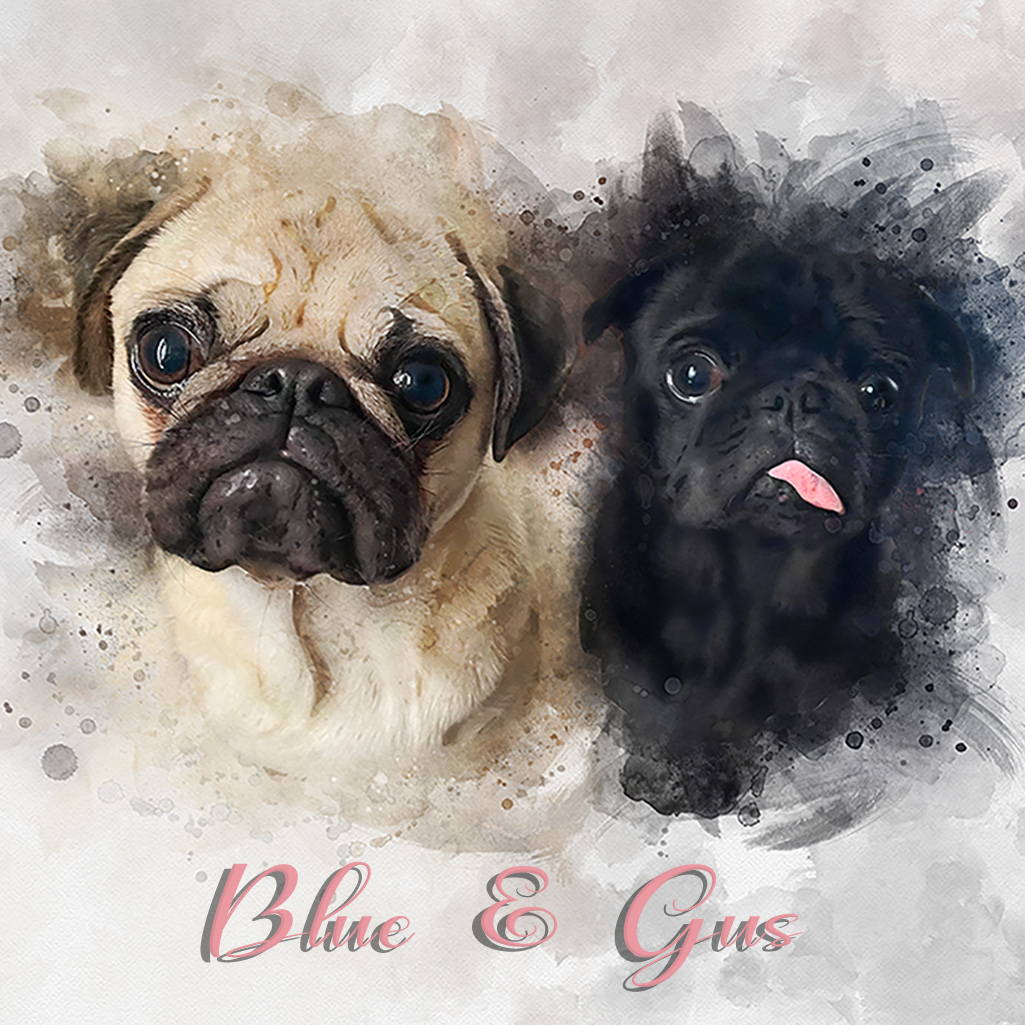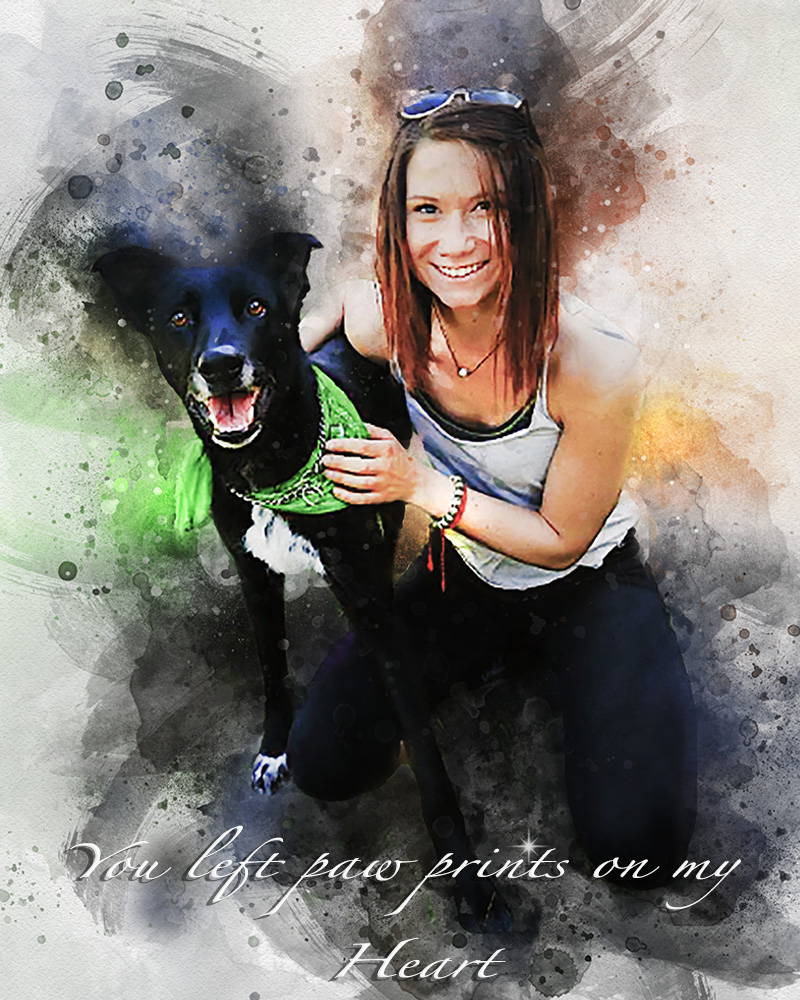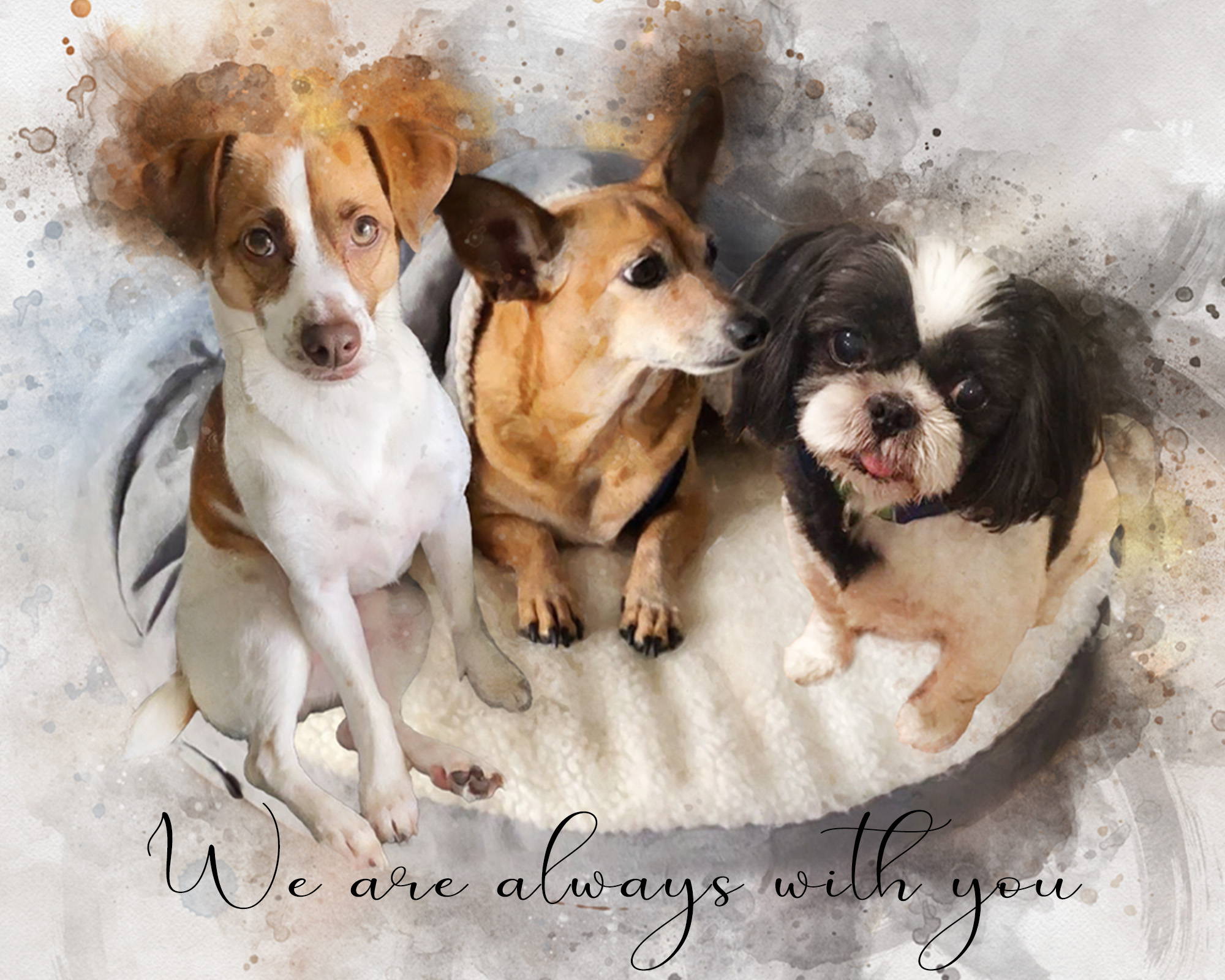
Custom Dog Paintings
Lily Phi
Transforming Precious Memories into Beautiful Custom Dog Paintings!
Hello there, fellow dog lovers! Today, I am thrilled to share with you my personal journey and the wonders of custom dog paintings. Our furry friends bring so much joy and unconditional love into our lives, and what better way to immortalize their adorable faces than through a stunning custom portrait painting? In this blog post, I'll guide you through the process of converting your favorite dog photo into a remarkable piece of art that captures the essence of your beloved canine companion. So, grab a cup of coffee, sit back, and let's dive into the world of custom dog paintings together!
The Magic of Custom Dog Paintings:
There's something truly magical about transforming a cherished photograph of your furry friend into a hand-painted masterpiece. Custom dog paintings not only capture the physical likeness of your canine companion but also bring their unique personality and spirit to life on canvas. Each digital brushstroke holds the love and devotion we feel for our furry family members, making these portraits a priceless treasure that will be cherished for generations to come.
Why Choose a Custom Dog Painting:
While photographs are undoubtedly wonderful keepsakes, a custom dog painting elevates the art of capturing your pet's essence to a whole new level. Here are a few compelling reasons why opting for a custom dog painting is a fantastic choice:
Celebrate the Uniqueness: Every dog is special and possesses their own distinct personality. A custom painting allows you to highlight their individuality and showcase their unique quirks and traits in a way that a photograph simply can't.
Immortalize Special Moments: Whether it's capturing their playful antics, their unwavering loyalty, or their loving gaze, a custom dog painting freezes those precious moments in time and preserves them forever.
Artistic Expression: Custom dog paintings are works of art created by talented artists who can bring out the beauty and character of your four-legged friend in a way that resonates emotionally. The digital brushstrokes, color palette, and attention to detail add a touch of artistic flair that goes beyond a simple snapshot.
The Process: From Photo to Painting:
Now that you're convinced of the magic a custom dog painting holds, let's explore the process of turning your favorite dog photo into a breathtaking piece of art. For this purpose, I highly recommend the online platform FromPicToArt.com, which specializes in transforming photos into stunning hand-painted portraits.
Step 1: Choose the Perfect Photo:
Selecting the right photo is key to capturing the true essence of your furry friend. Opt for a picture that showcases their unique personality, distinct features, and, most importantly, their expressive eyes. Remember, the eyes are the window to the soul, and they play a crucial role in bringing the painting to life.
Step 2: Visit FromPicToArt.com:
Head over to FromPicToArt.com, your one-stop destination for high-quality custom dog paintings. The user-friendly interface makes the entire process seamless and enjoyable.
Step 3: Upload and Customize:
Once on the website, click on the "Custom Dog Paintings" tab and follow the simple instructions to upload your chosen photo. FromPicToArt.com provides customization options such as selecting the desired canvas size, choosing a particular art style (realistic, impressionistic, or modern), and even adding personalized touches like a name or a special date to the painting.
Step 4: Creating:
After you've provided all the necessary details, FromPicToArt.com will assign your project to a skilled artist who will meticulously digitally hand-paint your custom dog portrait.
Step 5: Delivery and Display:
FromPicToArt.com takes great care in packaging and shipping your custom dog painting, ensuring it arrives safely at your doorstep. Once received, find the perfect spot to display your pet's masterpiece and let it serve as a constant reminder of the love and joy they bring into your life.
In a world where time seems to fly by too quickly, our canine companions provide unwavering love and companionship that is truly priceless. By choosing a custom dog painting, you can capture the essence of your furry friend and celebrate their unique personality in a way that photographs cannot. FromPicToArt.com is your ideal partner in this artistic endeavor, offering high-quality custom dog paintings that will leave you in awe.
So, what are you waiting for? Visit FromPicToArt.com today, upload your favorite dog photo, and embark on a journey to transform cherished memories into a stunning custom dog painting. Let the brushstrokes of talented artists capture the spirit of your furry friend, creating a timeless piece of art that will warm your heart for years to come.
Remember, the bond we share with our dogs is one of life's greatest gifts. Embrace this opportunity to honor their presence and create a legacy that will endure forever.
Visit FromPicToArt.com today and turn your beloved dog's photo into a captivating custom dog painting that will be treasured for a lifetime. Celebrate the unique bond you share with your furry friend and embark on an artistic adventure that will leave you in awe. Don't miss this chance to transform memories into masterpieces!
“FromPicToArt.com also offers gift certificates, allowing the recipient to choose their favorite photo and customize their painting according to their taste.”
Frequently Asked Questions about Custom Dog Paintings:
How long does it take to receive a custom dog painting?
The turnaround time for a custom dog painting varies depending on the complexity of the project and the artist's workload. Typically, it takes a few weeks from the time you place your order to when you receive the finished painting. However, it's important to remember that good art takes time, and the wait is undoubtedly worth it when you see the final result.
Can I order a custom dog painting as a gift for someone else?
Absolutely! Custom dog paintings make extraordinary gifts for dog lovers. Whether it's a birthday, anniversary, or any other special occasion, surprising a loved one with a personalized portrait of their beloved dog is sure to elicit joy and appreciation. FromPicToArt.com also offers gift certificates, allowing the recipient to choose their favorite photo and customize their painting according to their taste.
Are custom dog paintings only available for dogs?
While the focus of this blog post is on custom dog paintings, FromPicToArt.com offers custom pet portraits for various animals. Whether you have a cat, horse, bird, or any other beloved pet, you can transform their photo into a stunning hand-painted masterpiece.
Capture the Unconditional Love of Your Dog:
Our furry friends hold a special place in our hearts, and their love and companionship bring immeasurable joy to our lives. By investing in a custom dog painting, you can honor that bond and create a lasting tribute to their unwavering loyalty and affection. FromPicToArt.com is your trusted partner in this creative journey, providing high-quality custom dog paintings that beautifully capture the spirit and personality of your beloved pet.
So, dear dog lovers, don't miss out on the opportunity to turn your cherished dog photos into captivating works of art. Visit FromPicToArt.com today and embark on a memorable journey that celebrates the unique bond you share with your furry friend. Let their essence shine through brushstrokes and colors, reminding you of the love and joy they bring into your life each day.
Visit FromPicToArt.com now, explore their custom dog painting options, and order a one-of-a-kind masterpiece that will forever capture the spirit of your beloved canine companion. Cherish the memories, celebrate the love, and transform your favorite dog photo into a timeless work of art.
“FromPicToArt.com made the entire process easy and enjoyable. The painting captured our dog's playful nature and kind eyes perfectly.”
Customer Testimonials:
But don't just take my word for it. Let's hear what some satisfied customers have to say about their experience with FromPicToArt.com and their custom dog paintings:
"I was blown away by the custom dog painting I received from FromPicToArt.com. The artist truly captured every detail of my dog's face and personality. It's like looking into his soul every time I gaze at the painting. The process was seamless, and the team was incredibly responsive and accommodating. I highly recommend them!" - Sarah M.
"FromPicToArt.com exceeded my expectations with the custom dog painting they created for me. The attention to detail and the level of artistry is exceptional. They took a simple photograph and transformed it into a true work of art. I couldn't be happier with the final result!" - Michael T.
"I wanted to surprise my wife with a unique gift for our anniversary, and I decided on a custom dog painting of our beloved Labrador. FromPicToArt.com made the entire process easy and enjoyable. The painting captured our dog's playful nature and kind eyes perfectly. It was a gift that brought tears of joy to my wife's eyes. Thank you, FromPicToArt.com, for helping us create a lasting memory." - James R.
Now that you're aware of the beauty and significance of custom dog paintings, it's time to embark on this artistic journey and capture the essence of your furry companion. FromPicToArt.com stands out as a trusted online platform that can transform your favorite dog photo into a stunning hand-painted masterpiece. Their attention to detail, commitment to customer satisfaction, and talented artists ensure that your custom dog painting will become a cherished keepsake, celebrating the unconditional love and joy your dog brings into your life.
So, seize this opportunity to turn your beloved dog's photo into a captivating custom dog painting. Visit FromPicToArt.com today and let the artistic journey begin. Embrace the beauty of custom art and let it serve as a timeless tribute to the special bond you share with your furry friend.
Click here to visit FromPicToArt.com and order your custom dog painting today. Preserve the precious memories of your beloved dog in a stunning and unique way. FromPicToArt.com is your trusted partner in transforming photos into beautiful works of art.





